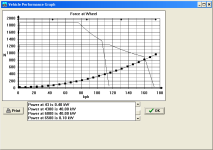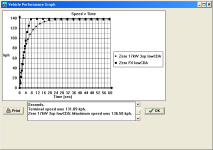Miles said:
Chalo said:
Confirms Luke's assertions, don't you think? About transmissions being a remedy for using the wrong motor for the job?
It's just a motor. Also sold as an industrial motor. The fact that it's
used as a model airplane part doesn't mean it's not suitable for bike use.
It can be made suitable, I'd say, through the use of a two-stage reduction (and in this case, multiple ratios). But it's not inherently right for the job, because its design speed and impedance match is a small air propeller, not a 50-75cm road wheel.
Because I like cycling speeds and conditions, I understand the benefits of a multiple speed transmission. We can use some of the same technical solutions to accommodate motors that have some of the same limitations as our own pedal power. But in pedal cycling, we don't get to choose among different motors-- we must work with what we've got.
In the case of an e-bike, the motor is just about the most arbitrary component of the system. What Luke is pointing out is that it is technically possible to just use a motor that does exactly the job you need done, and skip the efficiency loss, complexity, points of failure, weight, and expense of a mechanical transmission.
This was something I noticed when I first began messing with e-bike tech at the beginning of the century-- hub motors existed, but they weren't quite right for the purpose. Almost, but not quite. They were happiest running at RPMs too high for regular bicycle wheels, at power levels that weren't enough to reach the implied road speeds. I reckoned these issues would be sorted out in due course by making larger diameter motors, perhaps even in the rims of normal bike sized wheels. But most hub motors today have the same basic problem. They work best when they are fitted to ridiculous donut wheels.
It's like a combination of lack of imagination and ruthless cost engineering have held back hub motor design to something less than optimal for their known application. We can get hub motors that weigh 10kg and more, but we can't get them in a configuration that will efficiently drag a loaded normal bike up a steep grade at less than 1000W input power. If the motors were 16-20" in diameter, we wouldn't need to lace them to 16-20" wheels to make them do that.
Which brings me to my favorite multi-speed transmission, the Stokemonkey. What I like about Stokemonkey is that it makes the limitations of pedal power into one of its strengths. It exploits a facility that the bike already has available, with or without power assist. It may incur the same efficiency losses and tradeoffs as a pedal drive, but it is totally harmonious with the pedal drive, and thus the whole bicycle, as a result.
When pedal drive or "bicycleness" are not assumed, it makes less sense to use anything other than the best matching motor and controller for the RPM and torque requirements.





